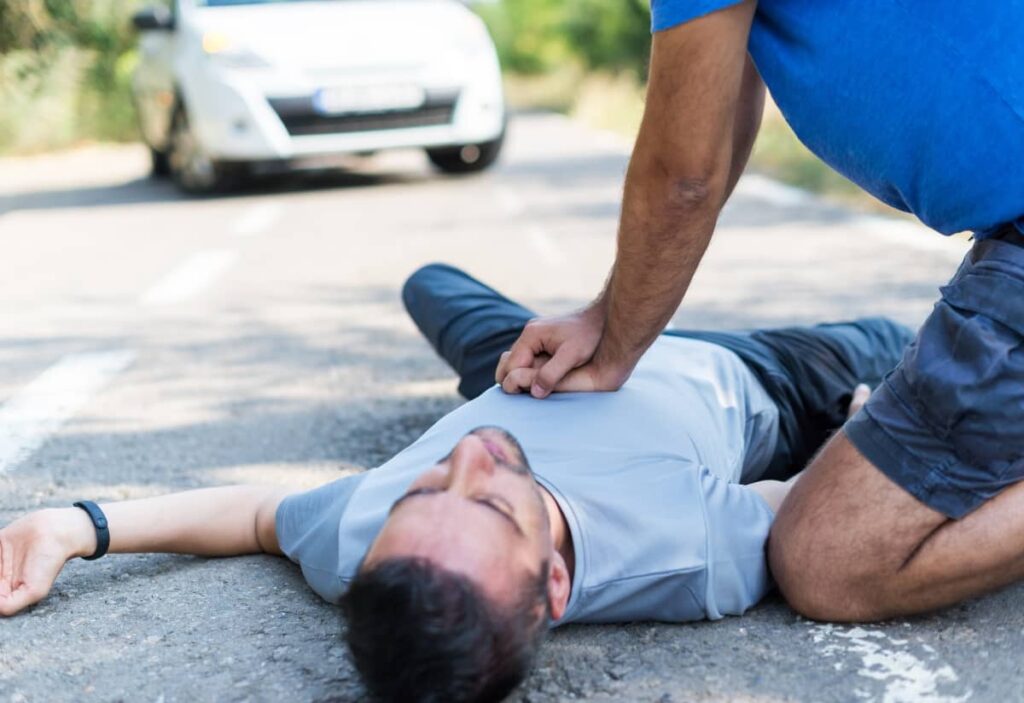From 2026, the UK Driver and Vehicle Standards Agency (DVSA) is set to add enhanced first aid content to the driving theory test. For the first time ever, those learning will be required to answer questions on CPR training as well as the use of public defibrillators. According to the DVSA, this won’t incur any extra cost and won’t make the tests any longer or more difficult.
This Could Make a Crucial Difference to Survival Rates
More than 40,000 out-of-hospital cardiac arrests happen in the UK each year, yet sadly, fewer than one in ten people survive. When chest compressions are delivered promptly, and an automated external defibrillator (AED) is used within three to five minutes, survival climbs to as much as 70%. What’s more, every minute without CPR and defibrillation actively lowers the chance of survival by up to 10%. All of this means that those bystanders who know how to do CPR and can use a public defibrillator make a critical difference to survival rates while emergency support is on the way
Drivers Encounter Cardiac Emergencies Regularly
Quite often, the person behind the wheel is the first on the scene of an emergency. Traffic collisions can trigger cardiac arrest through trauma or shock. Beyond this, drivers may encounter collapsed members of the public at service stations and bus stops. Giving them the confidence to begin compressions and deploy a nearby public defibrillator is, in that moment, more important than a medical background. That is exactly what the updated driving theory test changes aim to build.

What Will Change in the Driving Theory Test?
The multiple-choice question bank is going to expand to include practical CPR training knowledge and the safe use of AEDs. These are likely to centre around the correct compression depth for an adult (5 to 6 centimetres) and the best practices for using an AED. Official DVSA learning materials for car drivers are actually already being updated so that learners study evidence-based guidance on how to do CPR and defibrillator use.
What is the Scale of the Impact?
Roughly 2.4 million theory tests are taken annually, and nearly half of all candidates pass. That means hundreds of thousands of new drivers will carry consistent knowledge of CPR and defibrillation each year. Over the years, as those numbers build, the general public’s familiarity with AEDs and the nearest public defibrillator cabinet should rise, which lifts bystander intervention rates beyond today’s low baseline.
The Change Isn’t Going to Burden Learners
The updates add no time pressure or fees. The new questions just modernise existing first aid coverage in the test. The goal is to reinforce practical, memorable actions so that learners can answer in the exam and act decisively in the real world.

What Effective CPR Looks Like
The refreshed content focuses on simple, high-impact actions. For an unresponsive adult who is not breathing normally: call 999 on speaker, start chest compressions at 100 to 120 per minute, press down 5 to 6 centimetres in the centre of the chest, and allow full recoil.
If an AED is available, switch it on and follow its voice prompts immediately. These steps mirror widely adopted guidance and can be applied by anyone. By building them into the driving theory test and official study apps, the programme strengthens the link between knowledge and confident action.
How to create learning that sticks.
Skills are best retained when people see, hear, and practise the same technique. Short practice on a realistic chest that shows compression depth and recoil builds muscle memory. Pairing manikin time with an AED trainer reinforces pad placement, voice prompts, and safe shock delivery. Taking a blended approach like this helps knowledge learned for the exam convert into calm action at the roadside.
The Benefits are Community Wide
These adaptations to the driving theory test are part of a larger shift to embed lifesaving skills across the community. It’s already the case that various bodies across the UK provide free resources that explain how to do CPR and how to use an AED in clear steps. Signposting these links during the pre-test study could be a powerful way to encourage more learners into in-depth bystander CPR training. It may also embolden learners to locate the nearest public defibrillator using local registry maps.
Building Confidence Around AEDs
The mistaken belief that a defibrillator is only for clinicians has been proven to be a real barrier to providing lifesaving defibrillation during cardiac emergencies. Public access units are designed for anyone to use, with pads and prompts that minimise error. The driving theory test changes are likely to underline this by making “everyone” the correct answer when learners are asked who is able to use a public defibrillator. Another barrier is fear of doing harm. Modern AEDs analyse the heart rhythm and will not deliver a shock unless it is needed. Clear messaging on these points helps convert willingness into action.
Are there Implications for CPR Training and Assessment?
Training sessions can align lesson plans to the new emphasis by reinforcing hand placement, rate, depth, recoil, and minimal interruptions. Use of AED trainer devices should mirror the prompts learners will hear on public units. Where possible, practise locating a public defibrillator rapidly, opening the cabinet, and powering the unit. Instructors can weave in short drills based on common roadside settings to build speed and teamwork.
Need Tools that Turn Knowledge into Confident Action?
At Innosonian, we create evidence-based training tools that help people master CPR and defibrillation. Our range of Brayden manikins offers realistic chest mechanics with clear visual feedback in the form of LEDs, so learners can see effective compression depth and recoil in real time.
For public defibrillation practice, our AED trainer devices simulate pad placement and voice prompts to build calm, correct muscle memory. If you want CPR training sessions that turn theory into confident first response, then get in touch with us today to find out more about how we can help you.

